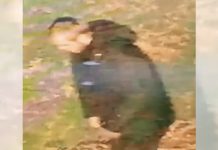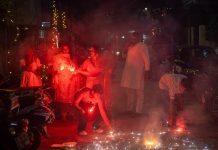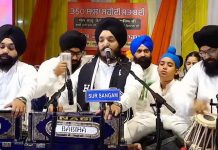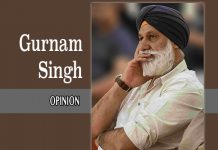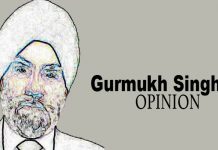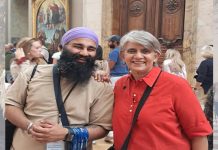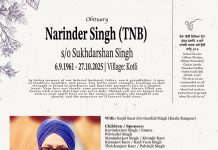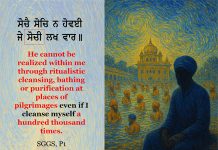
By Fatehpal Singh Tarney | Opinion | United States |
American troops go into combat with the idea that freedom isn’t free and they pay for it. That freedom includes freedom of religion. The country is more diverse than ever before and it is vital that the military reflects this reality.
There was a time when beards and long hair were acceptable and even commonplace in the American military. Civil War photos from both the Union and the Confederacy document this. My take is that all this changed when Prussian military prowess made an impact on the American military in the late 19th century. This included what was known as the Prussian “high and tight” haircut. There was always a mixed reaction to mustaches. I think there were better role models given that Prussian militarism contributed to both 20th century world wars.
I recall in Vietnam, a sergeant reprimanded for his mustache being too long. There are often times when the military prioritizes quite petty matters having little to do with winning a war. Trivial concerns adversely affect morale. When I think of impressive mustaches, I think of Field Marshall Sam Manekshaw, the Chief of the Army Staff of the Indian Army during the Indo-Pakistani War of 1971. Then there is Lt. General Jagjit Singh Aurora. Two of the world’s greatest military commanders!
The U.S. Marines are the military branch most resistant to change. Of course, there is a place for tradition and uniformity, but this can be excessive – especially in the Marine Corps. Marines resisted blacks joining and women serving in combat. Now, the percentage of blacks in the Marine Corps is higher than in any other service branch. Marine inconsistency is quite clear. During our great commitments in the Middle East, the Marines, desperate for recruits, were accepting enlistees with tattoos from head to toe – people who were rejected by the U.S. Army.

Marine resistance to change in previous decades often resulted in obsolete equipment! We went to Vietnam in 1965 with 1930 vintage suspender straps that were in no way useful in supporting a cartridge belt. We had WWII/Korean War metal canteens that were noisy and already rusted. My advantage was being fluent in Vietnamese, which enabled me to acquire stolen U.S. Army equipment from the local black market. I was quite popular given my ability to get plastic canteens (they neither rusted nor made noise in the bush), better suspender straps and rifle magazine pouches that were standard issue in the Army.
There are Sabat-Surat Sikhs [Sikhs who maintain their bodily hair] serving in other branches of the U.S. military with no negative effects on performance or morale.
The U.S. Marines, and so many other organizations, have a persistent inertia, which is a resistance to change – regardless of how positive that change could be. For example, “Why should we have observant Sikhs in the Marines now? We never had them before!” The Marines claim their boot camp (basic training) requires uniformity. What uniformity is achieved when there is one recruit with no ink next to another recruit with tattoos from head to toe?
The Marine Corps claims that beards put lives at risk. This is nonsense! It is interesting how many inter-service special operations personnel sport beards. These are the most elite troops we have with the most combat experience. Beards are considered jaunty in these units and manifest self-confidence. Moreover, the argument that beards prevent adequate seals on gas masks has been disproved time and time again here and in armies around the world.
I wish more military leaders and politicians in America would look closely at the diversity in the Indian and United Kingdom militaries and see that diversity is an asset – not a liability to effective performance in combat. Does respecting religious diversity in basic training programs in the Indian military adversely affect esprit de corps: pride, loyalty, and combat performance? I think not!

Franklin Paul Tarney [a.k.a. Fatehpal Singh Tarney], an ex-Marine of Vietnam era, has been a Sikh for over 40 years. He was very demoralized after the Vietnam War, but Lt. Gen. Jagjit Singh Aurora and his leadership in the 1971 Indo-Pakistani war stimulated by interest in Sikhi. He is proud to be one of the few Western Sikhs to have been president of a predominantly Punjabi Sadh Sangat. A retired history teacher and coach of tennis, soccer, and lacrosse, Tarney is actively involved in interfaith programs in Florida and Michigan. The initial version of the article was first published at Gurmat Learning Zone (GLZ), an email-based Gurmat discussion group.
RELATED STORY:
Sikhs sue US Marine Corps over restrictions on beards – NYT (Asia Samachar, 12 April 2022)
ASIA SAMACHAR is an online newspaper for Sikhs / Punjabis in Southeast Asia and beyond.Facebook | WhatsApp +6017-335-1399 | Email: asia.samachar@gmail.com | Twitter | Instagram | Obituary announcements, click here



